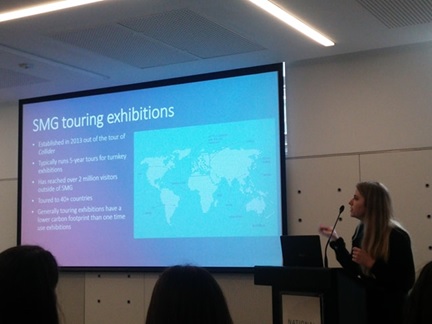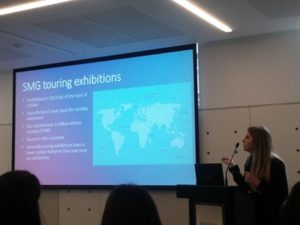
Sustainable touring exhibitions, current practices at the Science Museum Group.
Emily Cronin, Partnerships Manager, Cultural & Commercial Partnerships, Science Museum Group
Friday 7th February 2020 National Army Museum
The Science Museum Group touring exhibitions started in 2013 and they travelled to over 40 countries around the world.
Their exhibitions typically last approximately five years allowing them to reach a large audience and limit the carbon footprint compared to single exhibitions.
 Their touring exhibitions follow a sustainability model which includes using sustainable materials; trying to recycle touring exhibitions materials across the Science Museum Group sites or offering them to other venues; recycling what cannot be reused and employing contractors with sustainability in mind for example transport companies which reuse crates.
Their touring exhibitions follow a sustainability model which includes using sustainable materials; trying to recycle touring exhibitions materials across the Science Museum Group sites or offering them to other venues; recycling what cannot be reused and employing contractors with sustainability in mind for example transport companies which reuse crates. The Science Museum Group created the Blueprint Pack Exhibitions in order to increase sustainability for touring exhibitions. The Blueprint Pack consists in digital packages which are sent to the institutions hosting the exhibitions. Each pack contains the content, digital assets, research and design based on the exhibitions produced by the Science Museum Group and already displayed at one of their sites. The Blueprint Pack Exhibitions can fit a variety of spaces and each hiring institution can choose the materials for fabrication.
There are no physical objects lent with the Blueprint Pack Exhibitions and institutions can choose objects from their own collections or objects from local institutions which means the carbon footprint for transport is inexistent or significantly low.
The Science Museum Group Blueprint Pack exhibitions have travelled extensively creating collaborations with institutions as far as China, Mexico, U.S.A, Argentina, India, Russia and Singapore.
Sustainability remains a work in progress with possibility for further future developments.
Emily stressed the importance for registrars to incorporate sustainability requirements in the tender documents for contractors and concluded her presentation leaving us thinking on some ideas to be more sustainable. These include legacy projects for example making temporary installations/artworks permanent, transform objects for other uses and recycle and reuse.
Greta Gasacci, registrar National Galleries of Scotland

 Instagram
Instagram  LinkedIn
LinkedIn  Twitter
Twitter  My Account
My Account